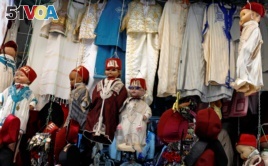20 January 2020
Leila Ben Gacem wants to rebuild an area in Tunisia known as the Medina of Tunis.
A local official in a village outside of the capital, Ben Gacem takes visitors to the ancient part of the city once known for specialized workers.
"Historically, the Medina was the heart of trade...and art, and it is structured with many souks," she said, adding that each souk is used by one kind of craftsman.
She said there are markets for coppersmiths, and for workers making Tunisia's famous chechia hat. The hat is exported to Libya and parts of Africa south of the Sahara Desert.

FILE - Dolls dressed in the traditional clothes are displayed at a clothing store at the Medina of Tunis, Tunisia, September 25, 2018. (REUTERS/Zoubeir Souissi)
Ben Gacem is also an entrepreneur with an idea. She wants to save the Medina's ancient buildings. She also hopes to bring back trades that once supported the historic area.
"Maybe the whole community will grow together," if investment in the area tries to bring in the whole community, she said.
This idea might help Tunisia's next government, which is still being organized three months after elections.
Tunisia is the only democracy to come out of the 2011 wave of popular protests in the Middle East known as The Arab Spring. The North African country is trying to give new life to its poor economy. It is also trying to fight the poverty that has pushed people to leave. Nearly 33 percent of Tunisia's young people do not have jobs. And yet, some craftsman in Medina are struggling to find and train workers.
A fading tradition
At his small shop, Mohammed Ben Sassi showed an old Quran he is working on. Its pages are drawn in blue and gold. Sixty-four-year-old Ben Sassi is the Medina's last bookbinder, a person who attaches covers to books.
"There's demand, but young people are no longer interested," Ben Sassi said.
He is not the only craftsman facing problems. Central Medina still has more than 500 artisan workshops. But, Ben Gacem's research has found that number is about half of what it was 50 years ago. She believes this is a great loss for the country's identity.
‘'Throughout history, Tunisians have worked with their hands," she said. "I can't imagine a Tunisian family that doesn't have an artisan."
There are many reasons for the decreasing number of artisans, Ben Gacem said. The country's failing economy and currency have made some quality materials very costly, forcing artisans to look for other jobs.
Bringing back these trades might also bring back an important part of the economy: tourism.
Tourism has largely rebuilt Tunisia's beaches and deserts, but it has not yet touched the Medina. The area is recognized by the United Nations as a UNESCO World Heritage Site.
"We're not promoting Tunisia with all its wealth, especially in the tourism industry," Ben Gacem said. "We haven't communicated the best story. We have communicated the easiest story."
Rebuilding the Medina
First built more than 1,000 years ago, the Tunis Medina was rebuilt under president Zine el Abidine Ben Ali. The area suffered during the 2011 revolution that ousted him. Building rules were not followed, longtime residents left, people illegally moved into the old homes and Tunisians from the south came to the area.
However, the revolution also had a good effect," said architect Soulef Aouididi of the Medina Conservation Association. The association's headquarters is in a beautiful, 19th-century palace. Aouididi said new local groups are opening up. They show the Medina to school children.
Aouididi's organization also brings people from many different neighborhoods. She said the group wants to help keep the old buildings as well as rebuild communities.
Nearby, two guesthouses offer another kind of community development. Ben Gacem has rebuilt two old Medina mansions into small tourist hotels. Local people operate them, and buy their goods from local businesses.
I'm Susan Shand.
Susan Shand adapted the Reuters story for VOA Learning English. Mario Ritter, Jr. was the editor.
Write to us in the Comments Section or on 51VOA.COM.
________________________________________________________________
Words in This Story
souk – n. a marketplace in North Africa or the Middle East
craftsman – n. a person who makes beautiful objects by hand
entrepreneur – n. a person who starts a business and is willing to risk loss in order to make money
Quran – n. the Muslim holy book
currency – n. the money that a country uses
tourism – n. the business of providing hotels, restaurants, entertainment, etc., for people who are traveling
promote – v. to encourage
mansion – n. a large house for someone wealthy